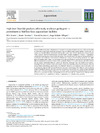Please use this identifier to cite or link to this item:
https://accedacris.ulpgc.es/jspui/handle/10553/75454
| DC Field | Value | Language |
|---|---|---|
| dc.contributor.author | Acosta Arbelo, Félix Antonio | en_US |
| dc.contributor.author | Montero Vítores, Daniel | en_US |
| dc.contributor.author | Izquierdo López, María Soledad | en_US |
| dc.contributor.author | Galindo Villegas, Jorge | en_US |
| dc.date.accessioned | 2020-11-12T10:55:09Z | - |
| dc.date.available | 2020-11-12T10:55:09Z | - |
| dc.date.issued | 2021 | en_US |
| dc.identifier.issn | 0044-8486 | en_US |
| dc.identifier.other | WoS | - |
| dc.identifier.uri | https://accedacris.ulpgc.es/handle/10553/75454 | - |
| dc.description.abstract | The use of effective biocides as disinfectants is essential in aquaculture facilities. However, while most biocides act effectively on free-living planktonic pathogens, they are seldom useful against biofilms. In this study, we evaluate the biocidal efficacy and antimicrobial specific contact time of three disinfectants, Virkon™Aquatic (VirA), peracetic acid (PerA) and hydrogen peroxide (HydP), on Vibrio anguillarum, V. harveyi, V. alginolyticus, and Photobacterium damselae subspecies piscicida against their both life phases. By using the minimum inhibitory, bactericidal, and eradication concentrations of disinfectants acting on the free-living planktonic state (MIC; MBC) and biofilms (MBIC; MBEC), we determined the in vitro susceptibility of each bacterial strain against three different individual concentrations of VirA, PerA, and HydP added at 1, 5, and 10 min intervals. PerA and VirA had the highest bactericidal efficacies against the free-living planktonic state and biofilm of all bacteria. Kinetically, PerA gave a positive result more quickly in both cases regardless of the strain in question, while the weakest HydP required longer than 10 min to act effectively. Moreover, we conducted a short in vivo safety trial by pouring the suggested MIC of each disinfectant into tanks containing juvenile Gilthead seabream (Sparus aurata). A significant mortality after 24 h was observed pointing to the potential risk a mishap of these chemicals might cause to fish. Nevertheless, collectively, our results support the inclusion of biocides within biosecurity protocols in aquaculture facilities and highlight PerA as the most effective disinfectant for fighting against biofilms produced by V. anguillarum, V. harveyi, V. alginolyticus or P. damselae subsp. piscicida. | en_US |
| dc.language | eng | en_US |
| dc.relation | Consumer driven Production: Integrating Innovative Approaches for Competitive and Sustainable Performance across the Mediterranean Aquaculture Value Chain | en_US |
| dc.relation.ispartof | Aquaculture | en_US |
| dc.source | Aquaculture [ISSN 0044-8486], v. 532, 736004 | en_US |
| dc.subject | 251092 Acuicultura marina | en_US |
| dc.subject | 310907 Patología | en_US |
| dc.subject | 310502 Piscicultura | en_US |
| dc.subject.other | Aquaculture | en_US |
| dc.subject.other | Biofilms | en_US |
| dc.subject.other | Bacterial hazard | en_US |
| dc.subject.other | Disinfection | en_US |
| dc.subject.other | Gilthead seabream | en_US |
| dc.subject.other | γ-Proteobacteria | en_US |
| dc.subject.other | Peracetic acid | en_US |
| dc.subject.other | Vibrionacea | en_US |
| dc.title | High-level biocidal products effectively eradicate pathogenic γ-proteobacteria biofilms from aquaculture facilities | en_US |
| dc.type | info:eu-repo/semantics/article | en_US |
| dc.type | Article | en_US |
| dc.identifier.doi | 10.1016/j.aquaculture.2020.736004 | en_US |
| dc.identifier.isi | 000600428000003 | - |
| dc.identifier.eissn | 1873-5622 | - |
| dc.relation.volume | 532 | en_US |
| dc.investigacion | Ciencias de la Salud | en_US |
| dc.type2 | Artículo | en_US |
| dc.contributor.daisngid | 40893708 | - |
| dc.contributor.daisngid | 233847 | - |
| dc.contributor.daisngid | 31444473 | - |
| dc.contributor.daisngid | 40566024 | - |
| dc.description.numberofpages | 10 | en_US |
| dc.utils.revision | Sí | en_US |
| dc.contributor.wosstandard | WOS:Acosta, F | - |
| dc.contributor.wosstandard | WOS:Montero, D | - |
| dc.contributor.wosstandard | WOS:Izquierdo, M | - |
| dc.contributor.wosstandard | WOS:Galindo-Villegas, J | - |
| dc.date.coverdate | Febrero 2021 | en_US |
| dc.identifier.ulpgc | Sí | en_US |
| dc.contributor.buulpgc | BU-VET | en_US |
| dc.description.sjr | 0,981 | |
| dc.description.jcr | 5,135 | |
| dc.description.sjrq | Q1 | |
| dc.description.jcrq | Q1 | |
| dc.description.scie | SCIE | |
| item.grantfulltext | open | - |
| item.fulltext | Con texto completo | - |
| crisitem.project.principalinvestigator | Izquierdo López, María Soledad | - |
| crisitem.author.dept | GIR Grupo de Investigación en Acuicultura | - |
| crisitem.author.dept | IU de Investigación en Acuicultura Sostenible y Ec | - |
| crisitem.author.dept | Departamento de Patología Animal, Producción Animal, Bromatología y Tecnología de Los Alimentos | - |
| crisitem.author.dept | GIR Grupo de Investigación en Acuicultura | - |
| crisitem.author.dept | IU de Investigación en Acuicultura Sostenible y Ec | - |
| crisitem.author.dept | Departamento de Biología | - |
| crisitem.author.dept | GIR Grupo de Investigación en Acuicultura | - |
| crisitem.author.dept | IU de Investigación en Acuicultura Sostenible y Ec | - |
| crisitem.author.dept | Departamento de Biología | - |
| crisitem.author.orcid | 0000-0002-1098-7529 | - |
| crisitem.author.orcid | 0000-0002-4358-2157 | - |
| crisitem.author.orcid | 0000-0003-4297-210X | - |
| crisitem.author.parentorg | IU de Investigación en Acuicultura Sostenible y Ec | - |
| crisitem.author.parentorg | IU de Investigación en Acuicultura Sostenible y Ec | - |
| crisitem.author.parentorg | IU de Investigación en Acuicultura Sostenible y Ec | - |
| crisitem.author.fullName | Acosta Arbelo, Félix Antonio | - |
| crisitem.author.fullName | Montero Vítores, Daniel | - |
| crisitem.author.fullName | Izquierdo López, María Soledad | - |
| Appears in Collections: | Artículos | |
WEB OF SCIENCETM
Citations
32
checked on Jun 8, 2025
Page view(s)
332
checked on Aug 10, 2024
Download(s)
211
checked on Aug 10, 2024
Google ScholarTM
Check
Altmetric
Share
Export metadata
Items in accedaCRIS are protected by copyright, with all rights reserved, unless otherwise indicated.
